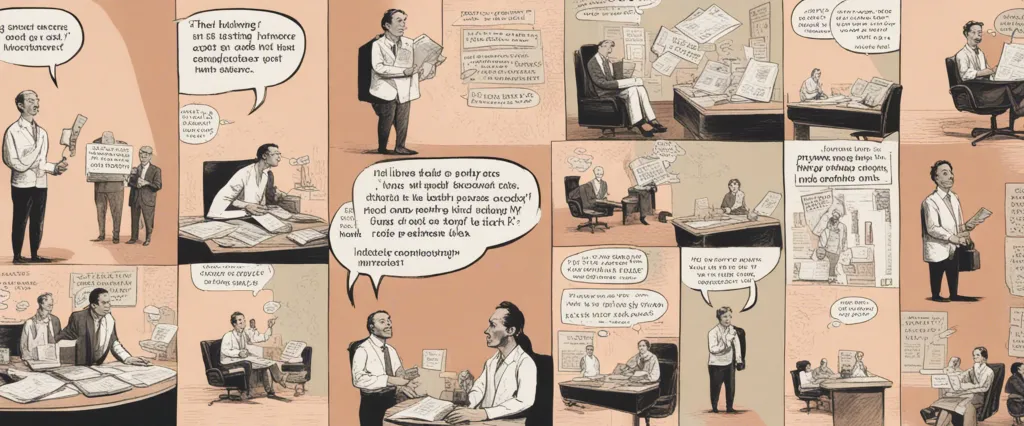In “The Barefoot Investor,” financial expert Scott Pape imparts his invaluable wisdom on achieving financial independence and securing a prosperous future. Drawing from personal experiences, Pape offers practical advice and step-by-step strategies to help readers eliminate debt, build wealth, and secure their financial well-being. Known as the “Barefoot Investor,” Pape believes in keeping financial matters simple, actionable, and accessible to all. With a background in finance and a passion for empowering others, Pape has become one of Australia’s most respected and renowned finance experts, revolutionizing the way people manage their money. Through his no-nonsense approach and relatable anecdotes, Pape provides readers with the tools they need to take charge of their financial lives and forge a path towards financial freedom and peace of mind.
Chapter 1: Plant
Chapter 1 of “The Barefoot Investor” by Scott Pape sets the foundation for the rest of the book by introducing the main concept of the book – achieving financial freedom and security. Pape argues that financial success is not just about making more money, but also about adopting the right mindset and having a clear plan.
The chapter begins with Pape reflecting on his childhood experiences with money. He shares an anecdote about receiving a windfall at the age of 11, only to lose it all due to poor financial advice from a financial advisor. This event shaped Pape’s perspective on money and motivated him to become the “Barefoot Investor” – someone who is financially independent and minimalist.
Pape introduces the concept of the “Barefoot Steps,” which encompass five key actions individuals should take to achieve financial success. These steps include creating a simple budget, setting up an emergency fund, paying off debt, buying your own home, and investing to secure financial independence. He emphasizes that these steps should be followed in sequence, with each step building upon the previous one.
Furthermore, Pape stresses the importance of adopting a long-term perspective when it comes to financial management. He encourages readers to invest in low-cost index funds, make regular contributions, and resist the temptation to leave investments untouched for decades. Pape also advises against engaging in speculative investments or trying to time the market.
Overall, Chapter 1 of “The Barefoot Investor” serves as an introduction to Pape’s philosophy and methodology for achieving financial freedom. It outlines the importance of mindset, the five Barefoot Steps, and the long-term approach to investing. Pape’s personal anecdotes and straightforward language make the complex world of finance accessible for readers of all backgrounds.
Chapter 2: Domino
Chapter 2: Domino of “The Barefoot Investor” by Scott Pape focuses on the power of small steps and creating a strong financial foundation. Pape introduces the concept of the financial domino, which is a metaphor for setting up each aspect of one’s financial life correctly to create a chain reaction of positive outcomes.
Pape starts by emphasizing the importance of having a clear vision of one’s financial goals. He encourages readers to identify what is truly important to them, whether it’s financial security, freedom, or the ability to live life on their own terms. By knowing their end goal, individuals can be motivated to take the necessary steps to achieve it.
The author then discusses the significance of setting up an emergency fund. Pape advises readers to save at least three months’ worth of living expenses in a separate high-interest savings account. This fund acts as a safety net and allows individuals to handle unexpected expenses without resorting to debt.
Next, Pape tackles the issue of reducing personal debt. He suggests using a “domino strategy” where the smallest debt is paid off first, followed by larger debts. This approach creates a sense of accomplishment and momentum, motivating individuals to continue the process until all debts are cleared.
Pape also emphasizes the importance of managing expenses and creating a streamlined financial system. He provides practical tips on reducing unnecessary expenses, such as renegotiating bills and optimizing insurance policies. The author advises readers to set up separate bank accounts for different purposes, such as daily expenses, bills, and savings, to efficiently manage their money.
In conclusion, Chapter 2 of “The Barefoot Investor” stresses the significance of building a solid financial foundation through saving for emergencies, paying off debts, and managing expenses effectively. By implementing these small steps, individuals can create a positive chain reaction and pave the way for long-term financial success.
Chapter 3: Mojo
Chapter 3 of “The Barefoot Investor” by Scott Pape, titled “Mojo: Saving for Rainy Days and Guilt-Free Spending,” focuses on establishing a system that allows individuals to effectively manage their money and regain financial control.
Pape emphasizes the importance of creating a “Mojo” account, which serves as a buffer for unexpected expenses and emergencies. He advises readers to set up an automatic transfer of 10% of their gross income into this account, treating it like a bill that must be paid. Additionally, he recommends having a separate everyday transaction account that receives the remaining 90% of one’s income.
To ensure guilt-free spending, Pape introduces a concept called “Splurge” accounts. These accounts are allocated towards specific expenses such as vacations, hobbies, or treats, and the money within them is used exclusively for these purposes. By allocating funds to these accounts in a structured manner, individuals can enjoy guilt-free spending while simultaneously staying on track with their overall financial goals.
Pape also emphasizes the importance of having a “Smile” account, which is specifically dedicated to donating and giving back to the community. Allocating 1% of one’s income to this account allows individuals to contribute to charitable causes and experience the positive impact of giving.
Furthermore, the author provides tips on reducing credit card debt, addressing the dangerous trap of compound interest and high-interest rates. Pape suggests paying off credit cards with the highest interest first, while making minimum payments on others, to gradually eliminate these debts.
Chapter 3 of “The Barefoot Investor” emphasizes the significance of creating a financial system that promotes mindful spending, while also preparing for unexpected expenses. By establishing Mojo, Splurge, and Smile accounts, readers can regain control of their finances, reduce debt, and ultimately achieve financial security.
Chapter 4: Splurge

Chapter 4 of “The Barefoot Investor” by Scott Pape is titled “Splurge” and focuses on how to enjoy the little pleasures in life while still maintaining control of your finances. This chapter aims to strike a balance between saving and spending, ensuring that you can indulge without jeopardizing your financial security.
Pape begins by discussing the importance of setting up an “mojo account,” which is a separate bank account used specifically for guilt-free spending. He emphasizes the significance of allocating a set amount of money into this account each payday, treating it as a reward for your hard work. By doing so, you can spend this money without feeling guilty, knowing that it is already factored into your budget.
Additionally, Pape emphasizes the concept of the “Splurge Daily” system, which allows you to allocate a small portion of your income toward small everyday indulgences. By setting aside a fixed amount each day, such as $5 or $10, you can treat yourself without going overboard. This system encourages conscious spending and enjoyment while still adhering to a budget.
The chapter also addresses the issue of overspending on big-ticket items. Pape suggests implementing a 10-second rule, where you pause for ten seconds before making a purchase over a pre-determined threshold, such as $100. This forces you to consider whether the purchase is truly necessary, helping to reduce impulse buying.
Moreover, Pape provides advice on negotiating prices and using discounts to save money on major purchases. He suggests researching prices, asking for discounts, or considering second-hand options before making a big-ticket purchase. Such strategies can help you save substantial amounts of money and ensure you are not overspending.
In summary, Chapter 4 of “The Barefoot Investor” teaches readers how to indulge and enjoy their money responsibly. By allocating funds to various guilt-free spending accounts, setting spending limits, and negotiating prices, individuals can strike a balance between enjoying life’s pleasures and maintaining financial stability.
Chapter 5: Blow
Chapter 5 of “The Barefoot Investor” by Scott Pape, titled “Blow,” focuses on how to protect oneself and loved ones in case of financial setbacks or emergencies. Pape describes these blows as unforeseen circumstances that can have a significant impact on one’s finances, such as an accident, illness, or loss of employment.
The chapter begins with Pape emphasizing the importance of having an emergency fund. He suggests setting up an online-only high-interest savings account, which he calls a “Mojo” account, and recommends saving at least three months worth of living expenses in it. Pape explains that this emergency fund will act as a safety net during challenging times and can prevent individuals from falling into debt.
Next, Pape advises readers to assess their insurance needs. He stresses the significance of having adequate health, life, and income protection insurance to shield against unexpected blows. Pape guides readers through the process of evaluating their current coverage and making necessary adjustments to ensure they have the appropriate level of protection.
Furthermore, the chapter addresses the significance of having a will and estate plan in place. Pape highlights the importance of seeking professional advice to ensure wishes are documented effectively and assets are distributed according to the individual’s desires.
Finally, Pape offers guidance on how to handle setbacks when they do occur. He emphasizes the importance of maintaining a positive mindset and not allowing setbacks to derail one’s financial progress. He advises readers to focus on finding opportunities for growth and using setbacks as a learning experience to improve their financial situation.
Overall, Chapter 5 of “The Barefoot Investor” emphasizes the importance of preparing for and navigating through unexpected financial blows by establishing an emergency fund, assessing insurance needs, and having a well-documented estate plan. Pape emphasizes the significance of proactive financial management and maintaining a resilient mindset when faced with setbacks.
Chapter 6: Mojo for Life
Chapter 6: Mojo for Life of the book “The Barefoot Investor” by Scott Pape focuses on the importance of building financial security and having a strong emergency fund, also known as mojo.
Pape starts by emphasizing that everyone experiences financial setbacks at some point, whether it’s unexpected medical expenses, a lost job, or a broken-down car. He highlights the vulnerability that comes with not having any savings or a safety net in these situations.
The author suggests that it is crucial to have at least three months’ worth of living expenses in your mojo account. Pape explains that these funds act as a buffer, allowing you to handle unexpected expenses without resorting to credit cards or payday loans. By having this safety net, you have the ability to maintain your financial stability, leading to less stress and worry about how to cover unexpected costs.
Pape provides practical advice on how to start building your mojo account. He emphasizes starting small, dedicating a portion of your income to savings regularly. He suggests automating the process so that a fixed amount is automatically transferred to your mojo account each month. It helps establish the habit of saving and ensures that you don’t forget or prioritize other expenses over saving.
The chapter also emphasizes the importance of creating a separate account solely for your mojo funds. Pape encourages readers to open an additional high-interest savings account dedicated solely to building and maintaining their emergency funds. He highlights the benefits of a separate account, including higher interest rates and the ability to easily track your progress towards your savings goal.
In summary, Chapter 6 of “The Barefoot Investor” highlights the significance of having a strong financial safety net, referred to as mojo. It stresses that building an emergency fund is crucial for financial security and provides practical steps for starting and maintaining these savings. By having enough money to handle unexpected expenses, individuals can experience greater peace of mind and avoid falling into debt or financial hardship.
Chapter 7: The Barefoot Investor for Families
Chapter 7 of “The Barefoot Investor for Families” by Scott Pape focuses on the importance of teaching children about money and equipping them with essential financial skills. Pape emphasizes that parents should start early and make financial education a priority as it plays a significant role in a child’s future financial success.
The chapter begins by outlining the steps parents can take to teach their children about money. Pape recommends setting up three jars or bank accounts: “Splurge,” “Smile,” and “Give.” The “Splurge” jar is for spending on things they desire, the “Smile” jar is for saving up for bigger purchases or goals, and the “Give” jar is for charity or helping others.
Pape also suggests implementing the concept of the “Bank of Mum and Dad” to teach children about borrowing and lending. By providing loans to their children and charging interest, parents can teach them about the cost and responsibility of borrowing money.
Additionally, the chapter emphasizes the importance of practical financial education. Pape advises bringing children along for grocery shopping and explaining the choices made based on cost and value for money. He also recommends involving children in decisions such as choosing utilities or insurance providers to help them understand the concepts of comparison shopping and finding the best deals.
Finally, Pape emphasizes the significance of leading by example. He encourages parents to display positive money habits and show their children the importance of setting financial goals and budgeting. By being open and transparent about family finances, parents can help their children understand the value of money and make informed financial decisions.
Overall, Chapter 7 of “The Barefoot Investor for Families” highlights the necessity of teaching children about money from a young age and provides practical strategies for parents to impart crucial financial skills to their children.

Chapter 8: The 60-Minute Barefoot Investor
Chapter 8: The 60-Minute Barefoot Investor of the book The Barefoot Investor by Scott Pape focuses on helping individuals take control of their financial life with just 60 minutes per month. Pape introduces a simple and effective system called the “Bucket Strategy” that consists of three main buckets: the Blow bucket, the Mojo bucket, and the Grow bucket.
The Blow bucket is for day-to-day expenses, including bills, groceries, and entertainment. Pape advises setting up an automatic account where a portion of your income is deposited for these expenses. He suggests using the debit card linked to this account for all daily transactions to avoid accumulating debt.
The Mojo bucket is meant to cover unexpected expenses and emergencies. Pape recommends setting up a separate account with at least three months’ worth of living expenses. This serves as a safety net and provides peace of mind in case of job loss or unforeseen circumstances.
Lastly, the Grow bucket focuses on long-term financial goals. Pape emphasizes the importance of investing and advises allocating a percentage of your income into high-growth investments, such as exchange-traded funds (ETFs). By regularly contributing a small portion of your earnings, you can benefit from compound interest and steadily grow your wealth over time.
To manage these buckets effectively, Pape suggests setting aside 60 minutes per month to review your finances, pay bills, and make any necessary adjustments. This regular check-up ensures you stay on top of your financial goals and make informed decisions.
In summary, Chapter 8 of The Barefoot Investor introduces the Bucket Strategy, which divides your finances into three categories to efficiently manage your money. By dedicating just 60 minutes per month to review and maintain your financial situation, you can gain control over your expenses, build an emergency fund, and work towards a prosperous financial future.
After Reading
In conclusion, “The Barefoot Investor” by Scott Pape provides readers with a practical and straightforward guide to managing their finances and achieving financial independence. Pape’s principles and strategies focus on saving, investing, eliminating debt, and building wealth in a way that is accessible to people from all financial backgrounds. The book’s emphasis on automation, simplicity, and long-term planning offers readers a roadmap to not only financial security but also financial freedom. Whether you are just starting your financial journey or looking to improve your current financial situation, “The Barefoot Investor” offers invaluable advice and actionable steps to take control of your money and thrive financially.
1. Rich Dad, Poor Dad” by Robert T. Kiyosaki – This book focuses on financial education and the importance of financial literacy. It offers practical advice on how to build wealth and achieve financial independence.
2. “The Total Money Makeover” by Dave Ramsey – Dave Ramsey provides a step-by-step guide for getting out of debt and taking control of your finances. His strategies and principles have helped millions of people transform their financial lives.
3. “Smart Women Finish Rich” by David Bach – Geared towards women, this book emphasizes the importance of financial independence and provides practical tips on managing money, investing, and planning for a secure future.
4. “I Will Teach You to Be Rich” by Ramit Sethi – Ramit Sethi breaks down complex financial concepts into simple, actionable steps for young adults. He covers topics such as budgeting, saving, investing, and automating your finances.
5. The 4-Hour Workweek” by Timothy Ferriss – While not solely focused on personal finance, this book challenges traditional notions of work and introduces strategies to create more time and financial freedom. Ferriss provides insights into how to design your life and make money in non-traditional ways.
These books offer a similar focus on personal finance, financial independence, and wealth-building. They provide practical advice and actionable steps to help readers take control of their finances and improve their financial well-being.




